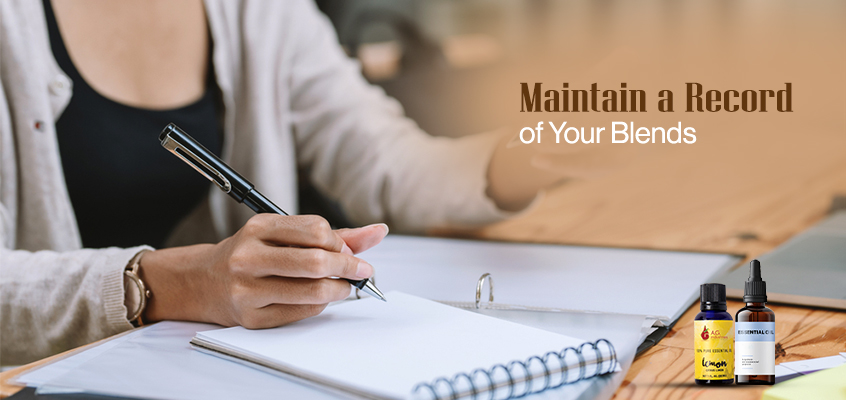Essential Oil Blending Tips for Creating Signature Fragrances in Cosmetics

Essential oil blending is an art form that calls for imagination, exploration, and patience. Essential oils are concentrated plant extracts that have a broad range of medicinal uses as well as the ability to produce special and alluring scents.
In this article, we will discuss the technique of blending essential oils to produce specific aromas that can be applied to aromatherapy, perfumes, and other products.

A Perfect Set Up For a Perfect Blend
Creating a one-of-a-kind blend to match your mood or desired scent profile is both exciting and interesting. It's also easier than you might think after a little practice.
Also, you need to set up a blending station before you get too far into the process. For that, you need a small amber glass bottle for your blends, pipettes, perfume test strips, paper, and a pencil for recording both good and bad results.
You can have a few fresh coffee beans to clear up your nose in case it is overloaded with a lot of aromas. However, the best way to keep your olfactory system from becoming overloaded is to go outside and take in some fresh air for a reboot!
- Actual Intent Before you begin blending, you must first recognize the purpose of the creation. You can do this by visualizing the scent you want to create, emphasizing the notes and the use of the blend.
- Learn the Fundamentals of Essential Oil Blending It's critical to understand the fundamentals of fragrance families and notes when blending essential oils. Fragrance families are collections of scents with common traits, such as floral, citrus, or woody. The different layers of a fragrance are represented by notes, which include top, middle, and base notes.

- Top Notes Makes up 10-20% of the mix Every essential oil has a Top Note, a Middle Note, and a Base Note. The volatility, fragrance type (citrus, woodsy, floral), and depth of the perfume define these categorizations. Top notes often fade quickly and are energizing and pleasant. Its great volatility is what gives a mix its first impression.
- Common oils in the top note will be: Basil, Bergamot, Clary Sage, Eucalyptus, Grapefruit, Lemon, Lemongrass, Peppermint, Petitgrain, and Spearmint
- Middle Notes or Body Notes Makes up 60-80% of the mix These essential oils will contribute a significant portion of the scent. They are less volatile than the Top Notes and will take a bit longer to become noticeable (typically 20-60 minutes after application). They expand over time, rising to the surface as the top note fades, imparting a warm, delicate aroma to the composition. Common oils in the middle note will be: Black Pepper, Cardamom, Cypress, Sweet Fennel, Geranium, Juniper Berry, Marjoram, Melissa, Oregano, Roman Chamomile, Rosemary, Spikenard, Thyme, and Siberian Fir.
- Base Notes It accounts for 10-20% of the whole mix. These essential oils will have a stronger scent. These will be noticeable for a long time (usually an hour or two after application), and they will also inhibit the evaporation of the oils from the top two notes. They will often have a very rich aroma that is also extremely calming in nature.
- Common oils in the base note will be: Blue Tansy, Cassia, Cedarwood, Cinnamon Bark, Clove Bud, Frankincense, Ginger, Helichrysum, Jasmine, Myrrh, Patchouli, Rose, Sandalwood, Vetiver.
-
Let Your Blend Mature
Let your essential oil mix sit for a few days after you've made it to allow the oils to combine and develop. This will provide you with a better sense of how the scent will change over time. You may need to make some adjustments to the blend, so be gentle and take your time getting it right.
-
Maintain a Record of Your Blends

It's extremely important to keep notes of your essential oil blends as you experiment with them so you can reconstruct them in the future. Keep a record of your experiments by labeling each mix with the oils used and the ratio.
Conclusion
To summarize, combining essential oils to produce unique aromas is a satisfying and interesting process that can be used in aromatherapy, perfumes, and other applications. You can develop remarkable and attractive aromas that provoke a desired emotional reaction by starting with a reason, learning the principles of fragrance mixing, selecting high-quality oils, experimenting with ratios, and allowing your blend to grow.
Keep track of your mixes so you can reproduce them in the future while also experimenting and refining your skills. With a little research and artistry, you can create absolutely unique signature scents.
You May Also Like:
- 7 Must Have Personal Care Cosmetic Products
- Revolutionizing Beauty Products with Natural Essential Oils
- Tips and Tricks : Unlock Your Skin’s Potential with Aloe Vera
- Be Holi Ready with Pre & Post Skincare and Haircare Tips
- Sexual Wellness And Pleasures: How To Achieve Them?
- Skin Fasting: What Is It And Does It Even Work ?
- Waterless Beauty Is An Ancient Indian
